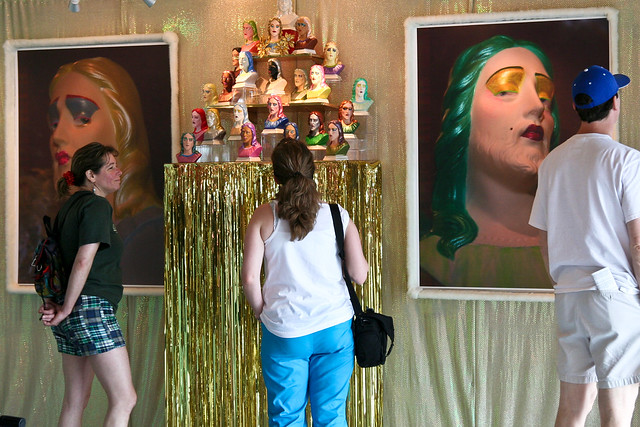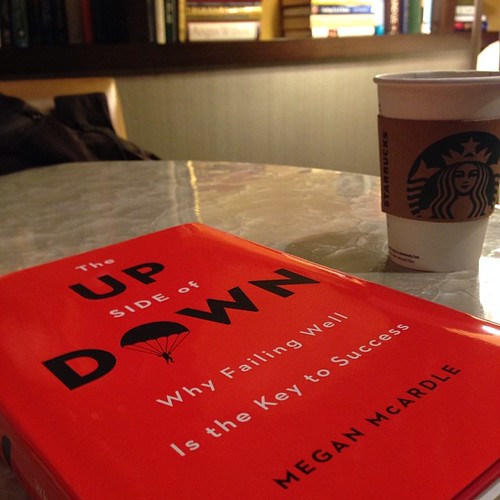
Artomatic is ten floors of bad art. Held every couple years in an abandoned office building, it’s a multi-week, multimedia arts event held in the Washington, DC area. Artomatic is non-juried. Pay a small fee and you’re given a section of wall to hang your work on. Like some sort of bizarre department store, Artomatic is home to thousands of square feet of slapdash painting, crude sculpture and out-of-focus photography. Added to this joyful mix of mediocrity are garage bands, freelance DJs, teen dance crews and deeply personal works of unwatchable performance art.
It really sucks. But that’s the key to its success. There’s an undeniable energy to the experience that you won’t find in some staid museum. No curators organized the art for you. The lighting is harsh. There is no audio tour. And around the corner could be anything – photos of Keds, a male nude or some impressionistic take on your home town that you fall in love with.
Artomatic celebrates the artist. It is about the messy process of art, as you struggle to achieve perfection with the most imperfect of materials: yourself.
As the author of two novels, I’ve met plenty of people over the years who say they have the perfect idea for a book. It’s so brilliant that they hesitate to even tell me about it. Maybe it’s the next War and Peace.
But we never find out because they never write it.
There’s a great chapter in The Up Side of Down by Megan McAardle about writers, procrastination and the fear of failure. We put off work because we’re afraid that our work won’t be perfect. We have the perfect manuscript – in our heads – but in writing it down, it will inevitably be corrupted by our imperfections, ending up like one of the misbegotten pieces hanging on the walls of Artomatic.
Yet, despite the psychological peril, writing gets done. Novels are written, screenplays drafted, poetry composed. Why?
“Work finally begins,” says Alain de Botton, “when the fear of doing nothing exceeds the fear of doing it badly.”
McArdle has her own advice for writers: you have permission to suck. Your first draft doesn’t have to be perfect. It can be terrible. But get it done and get it on the page. You can fix a bad first draft; you can’t fix nothing.
Letting go of perfection is freeing. Tom Wolfe’s career began with a case of writer’s block, after being hired to write an article for Esquire:
I was totally blocked. I now know what writer’s block is. It’s the fear you cannot do what you’ve announced to someone else you can do, or else the fear that it isn’t worth doing. That’s a rarer form. In this case I suddenly realized I’d never written a magazine article before and I just felt I couldn’t do it. Well, Dobell somehow shamed me into writing down the notes that I had taken in my reporting… so that some competent writer could convert them into a magazine piece. I sat down one night and started writing a memorandum to him as fast as I could, just to get the ordeal over with. It became very much like a letter that you would write to a friend in which you’re not thinking about style, you’re just pouring it all out, and I churned it out all night long, forty typewritten, triple-spaced pages. I turned it in in the morning to Byron at Esquire, and then I went home to sleep. About four that afternoon I got a call from him telling me, Well, we’re knocking the “Dear Byron” off the top of your memo, and we’re running the piece.
You have a unique story to tell. But only if you share it. Let go of perfection and write it down in all its messy glory. It’s not going to be the idealized version in your head. It’s going to have rough edges and jagged corners. It might lack supporting beams and doors and windows. All of these problems can all be fixed – but only if you have the raw material to work with. You can’t reshape illusions.
Your work may be as flawed and imperfect as the art hanging on the walls of Artomatic. But it will be real. It will exist in the world. And imperfect art is better than no art at all.

 McArdle’s career illustrates this principle. An MBA who was jobless following 9/11, she (among other activities) started blogging, which led to positions at The Economist, the Atlantic and
McArdle’s career illustrates this principle. An MBA who was jobless following 9/11, she (among other activities) started blogging, which led to positions at The Economist, the Atlantic and